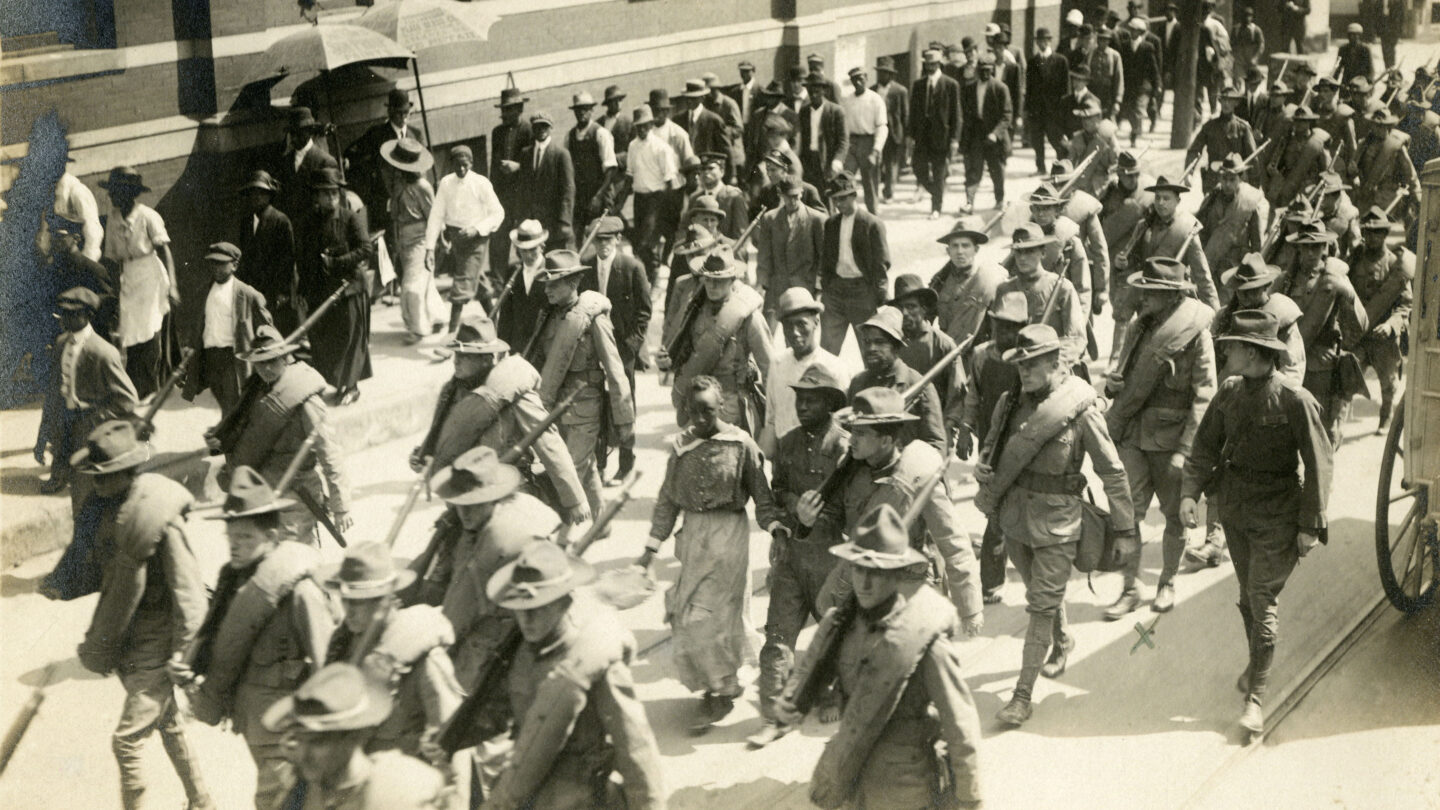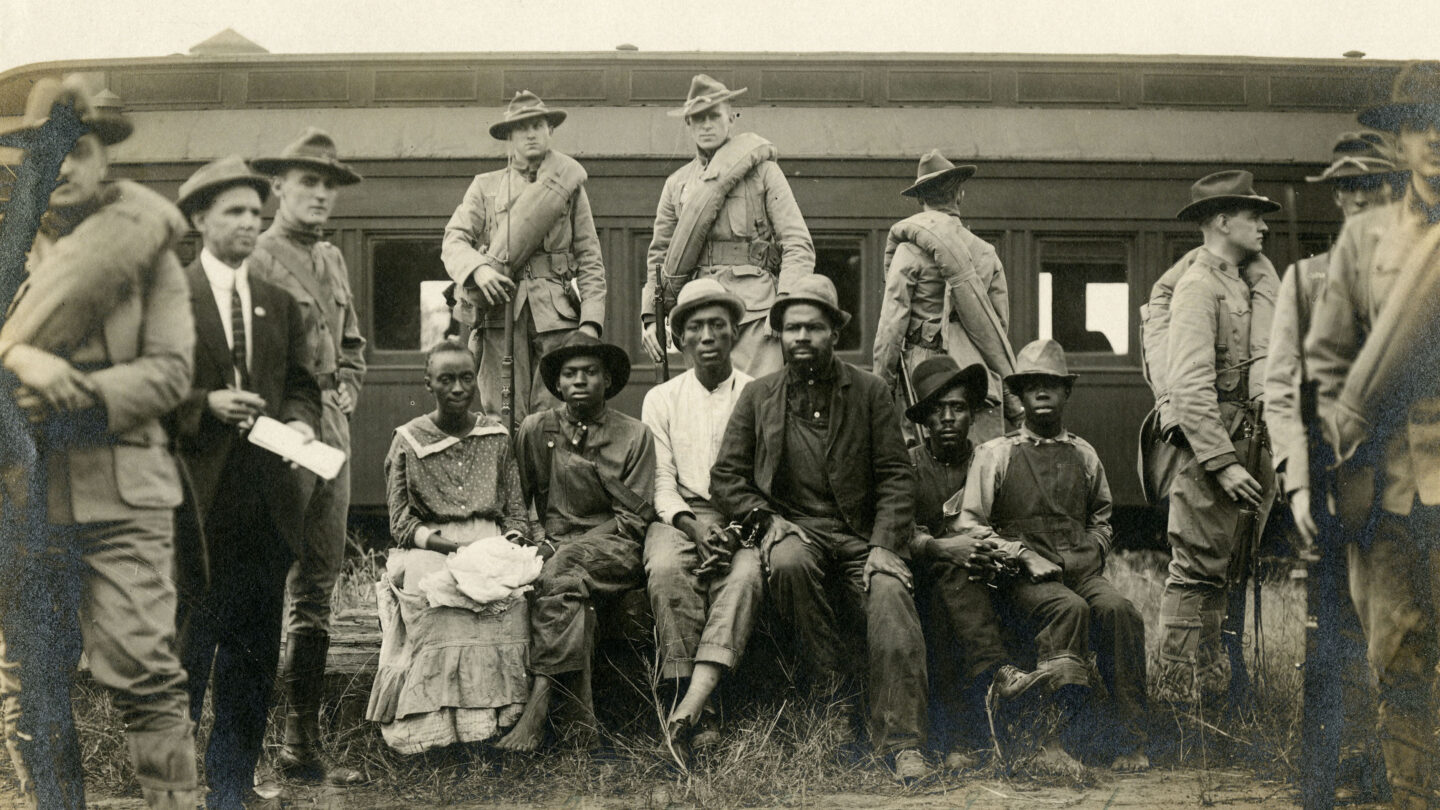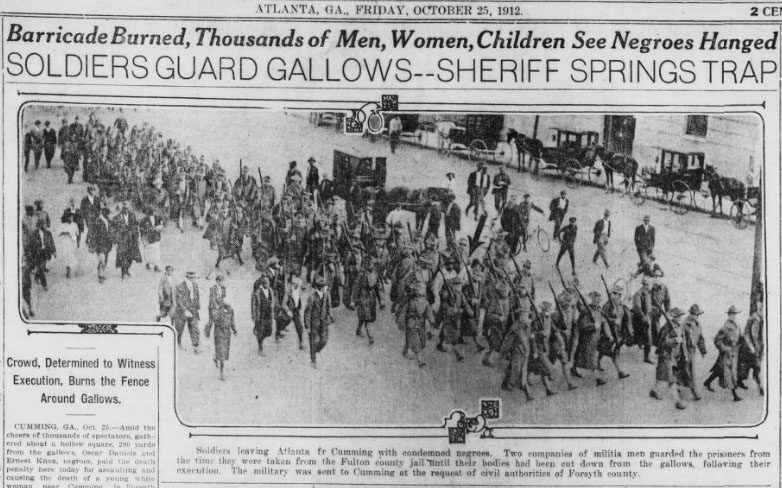Editor’s note: Atlanta History Center is uncovering and sharing the histories of the descendants of Forsyth County’s Black residents who were expelled in 1912. If you are a descendant of the 1912 Forsyth County displacement, contact us at forsyth1912@atlantahistorycenter.com.
In 1912, several significant world events occurred. The Republic of China was established on January 1, following the overthrow of the Qing dynasty in 1911. The African National Congress (ANC) was founded in South Africa on January 8 to oppose the apartheid system. The Titanic sank on April 15, which resulted in the deaths of more than 1,500 passengers and crew members. The first American film studio, Universal Studios, was founded on April 30 in California. In November, New Jersey Governor Woodrow Wilson defeated Theodore Roosevelt and William Howard Taft to become president of the United States.
The year 1912 was also a time of continued racial violence in the South. In the South, whites regularly used lynchings to control the Black population. That year—just six years after the Atlanta Race Massacre and three years before the reorganization of the Ku Klux Klan in Stone Mountain, Georgia—three Black men who lived in Oscarville, a small community in the Newbridge district of Forsyth County, Georgia, were arrested and executed for brutally assaulting a local white woman, Mae Crow.
Crow was found in the woods near her home. She was unconscious, and she had been sexually assaulted. Forsyth County Sheriff Bill Reid arrested Rob Edwards, Ernest Knox, and Oscar Daniel and accused them of participating in the attack. A mob of white locals lynched Edwards in downtown Cumming, while Knox and Daniel were convicted by an all-white jury and executed for sexually assaulting and murdering Crow. These events culminated in the forced displacement of more than 1,000 Black people from the county and an informal ban on Black residents living there until the 1990s.
Timeline of Events
September 5, 1912
Ellen Grice, 22, a white resident of Forsyth County, claims a Black man entered her home at night and attacked her while her husband was away. When her husband returns, he and others begin a search for the man who attempted to assault her. The search party captures Toney Howell, 22, and accuses him of being the attacker. Forsyth County Sheriff Bill Reid arrests Howell and four others, Isaiah Pirkle, 35, Joe Rogers, 24, Fate Chester, and Johnny Bates, as accomplices. He takes them to the jail in Cumming.
“Threatened Lynching at Cumming Averted; State Troops on Duty,” Atlanta Georgian, September 7, 1912. https://www.newspapers.com/image/876869328/?terms=%22appeals%20of%20officers%20and%20ministers%22&match=1 (detail).
September 7, 1912
As white residents of Forsyth County learn of the arrest of the five Black men, they form a mob at the jailhouse in Cumming. A local Black preacher, Reverend Grant Smith, goes to the jailhouse after hearing the news. Smith comments to the crowd that Grice is a “sorry white woman.” In response, the white mob, which had grown to the size of a few hundred, turns their attention to Smith and brutally beats him. Sheriff Reid and Deputy Gay Lummus intervene and shelter Smith in the courthouse.
At this time, many in Cumming’s Black community were gathered at the Colored Methodist Campground in the “Negro quarter” for an annual barbecue. When they learn that the sheriff has arrested Howell and a mob has beaten Smith, men from the barbecue begin to make their way to downtown Cumming. Their movement sparks a rumor that Black people were heading to the town center with explosives to dynamite the town. In response to the tale, more whites with firearms head to the town square. When the Black men who had traveled to the jailhouse arrive, about 500 white residents await them.
The white men in the crowd chase the Black men away while Cumming Mayor Charlie Harris attempts to calm the public, encouraging them to disperse and return to their homes. The white mob refuses. Mayor Harris contacts Georgia Governor Joseph Brown and asks him to send the Georgia National Guard to break up the crowd. Governor Brown deploys the closest national guard unit. The members of the national guard travel by car from Marietta and arrive in downtown Cumming. When the national guard arrives, the crowd finally disperses.
September 8, 1912
Amid the accusations by Ellen Grice and the beating of Reverend Grant Smith, a white resident of Oscarville, Mae Crow, 18, goes missing after visiting her aunt.
“Girl, 18, Throat Cut, Found Unconscious in Woods Near Cumming,” Atlanta Georgian, September 9, 1912. https://www.newspapers.com/image/876869357/?terms=throat%20cut&match=1 (detail).
September 9, 1912
A search party discovers Crow, unconscious but still alive, with her throat slashed in the woods near her home. A search party member also finds a small pocket mirror in the woods but does not specify how close it was to the crime scene. Crow’s family takes her home in her unconscious state.
People gather nearby to see what is going on. Only a short distance away at Pleasant Grove Church, a group of Black teenagers gather to watch. Among them is Oscarville resident Ernest Knox, 17. Knox had only recently moved to the county to live with his extended family, the Daniels. Knox and the Daniel family are some of the only Black individuals living in this area of Forsyth County. According to the 1910 census, 513 people lived in the New Bridge district, and only 37 of those 513 were Black residents.
A prominent community member approaches Knox and asks if he owns the mirror. Knox admits to owning it. It is unclear whether Knox knows that a search party has found Mae Crow’s body and his mirror in the woods.
After being coerced, Knox admits to attacking Crow. Following his confession, white residents turn Knox over to the authorities. Sheriff Reid arrests Knox.
News spread quickly about Knox’s arrest. To prevent another mob attack, authorities take Knox to the Fulton County Jail, commonly known as the “Fulton Tower” or the “Tower.” People spread rumors that Knox has accomplices.
“Negro Suspect Lynched in Jail.” Morning Call, September 11, 1912. https://www.newspapers.com/image/552635022/?terms=%22negro%20suspect%20lynched%20in%20jail%22&match=1 (detail)
September 10, 1912
In the morning, white men in the county imprison Rob Edwards, 24, and turn him over to Sheriff Reid. Sheriff Reid arrests Edwards as an accomplice in the Crow attack. Edwards is the common-law husband of Jane “Trussie” Daniel, 21, Knox’s cousin. Sheriff Reid transports Edwards to the Cumming jail. As news spreads of Edwards’ arrest, at least 2,000 white men swarm the small jail, prepared to murder him. Men from the mob break into the jail and bring Edwards outside. They lynch Edwards by hanging him from a telephone pole in downtown Cumming. They shoot his lifeless body, riddling it with bullets.
“Negroes Flee from Forsyth,” Atlanta Constitution, October 13, 1912. https://www.newspapers.com/image/26784458/?terms=%22negroes%20flee%20from%20forsyth&match=1 (detail).
September 1912
Sheriff Reid arrests three more Black residents of Oscarville concerning the assault on Crow. Jane Daniel, Oscar Daniel, Jane’s 17-year-old brother, and Ed Collins, their 27-year-old neighbor, are all arrested and transported to the Tower.
In the aftermath of Edward’s lynching, white residents of Forsyth County begin terrorizing Black families who live there. Groups of white vigilantes in Forsyth use various methods, including threats and arson, to compel Blacks to leave the county. Newspapers report that white residents burned Black churches and distributed notices encouraging Black residents to flee. They also raided Black homes and damaged the buildings by shooting with rifles and other weapons. In the face of these attacks, Black residents flee in droves, many taking only what they can carry. Black landowners abandon their property or sell it at a loss.
September 23, 1912
Mae Crow dies from injuries sustained during the attack. Because she never regains consciousness, Crow never implicates anyone in her attack. She is buried at Pleasant Grove Church, a short distance from her home on Durand Road in Oscarville. With Crow’s death, Jane and Oscar Daniel, Knox, and Collins are charged with murder in addition to their original sexual assault charge.

Accused prisoners escorted by the Georgia National Guard to Atlanta train station, October 2, 1912. DuBose Family Visual Arts Materials, VIS.198.149.002. Kenan Research Center at Atlanta History Center.
October 2, 1912
Everyone detained for the assault and murder of Mae Crow leaves the Fulton Tower in Atlanta to go to Cumming for their trial on October 3, 1912.
There is no train to Cumming, so the prisoners ride the train to Buford, Georgia, and walk to Cumming. The Georgia National Guard escorts them to quell any mob violence, and they spend the night at a camp set up by military personnel. Judge Newton Morris, a superior court judge of the Blue Ridge Circuit, oversees the trial. Judge Morris appoints attorneys to represent Jane and Oscar Daniel, Knox, and Collins. The lawyers object to defending the accused.

The accused prisoners in Buford, Georgia, before their trial. From left to right, Jane Daniel, Oscar Daniel, Toney Howell, Ed Collins, Isaiah Pirkle, and Ernest Knox. DuBose Family Visual Arts Materials, VIS 198.149.001, Kenan Research Center at Atlanta History Center.
October 3–4, 1912
At trial, prosecutors offer the narrative that Knox, Oscar Daniel, and Edwards attacked and assaulted Mae Crow while Jane Daniel held a lantern borrowed from Ed Collins. Collins and Jane Daniel corroborate this story through their witness testimony. Knox and Oscar Daniel have separate trials. Oscar Daniel maintains his innocence throughout his trial. Nevertheless, all-white juries convict Knox and Oscar Daniel of the sexual assault and murder of Mae Crow. Judge Morris sentences the two men to execution by hanging.
Judge Morris also plans to have a trial for Toney Howell for the attempted sexual assault on Ellen Grice, but no witnesses show up.
The Georgia National Guard transports Knox, Oscar Daniel, and Howell back to the Fulton Tower.
Judge Morris sets an execution date of October 25, 1912, for Knox and Oscar Daniel. He also orders that the hangings be private and only be witnessed by relatives and relevant law officers.
October 24, 1912
Leading up to the hanging, Dr. Ansel Strickland offers his land as an arena for the hanging. Despite the orders of Judge Morris, Sheriff Reid has gallows erected for the hanging in Dr. Strickland’s large open field. While Sheriff Reid oversees building a 15-foot-high privacy fence, a mob goes to the site at night and tears down and burns the fence in a bonfire. The mob does this without interference from Dr. Strickland or Sheriff Reid.

“Soldiers Guard Gallows-Sheriff Springs Trap,” Atlanta Georgian, October 25, 1912. https://www.newspapers.com/image/876872274/?terms=%22soldiers%20guard%20gallows%22&match=1 (detail).
October 25, 1912
Sheriff Reid claims the fence cannot be rebuilt in time for a private execution. Thousands pour into the open field to gawk at Ernest Knox and Oscar Daniel and watch their execution.
End of 1912
By the end of 1912, white Forsyth County residents had forced most of the Black people who lived in the county to leave. They migrate to nearby counties seeking safety.

